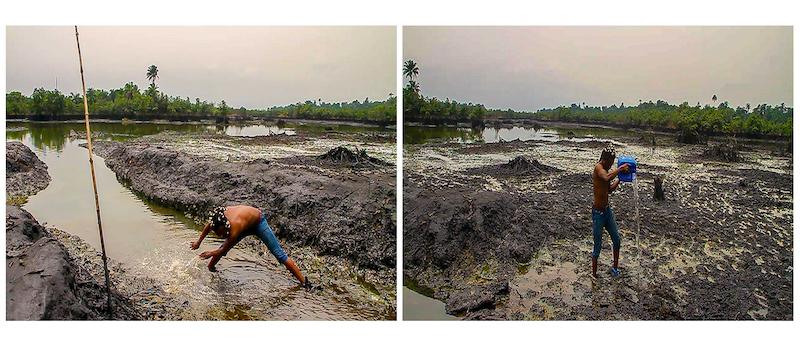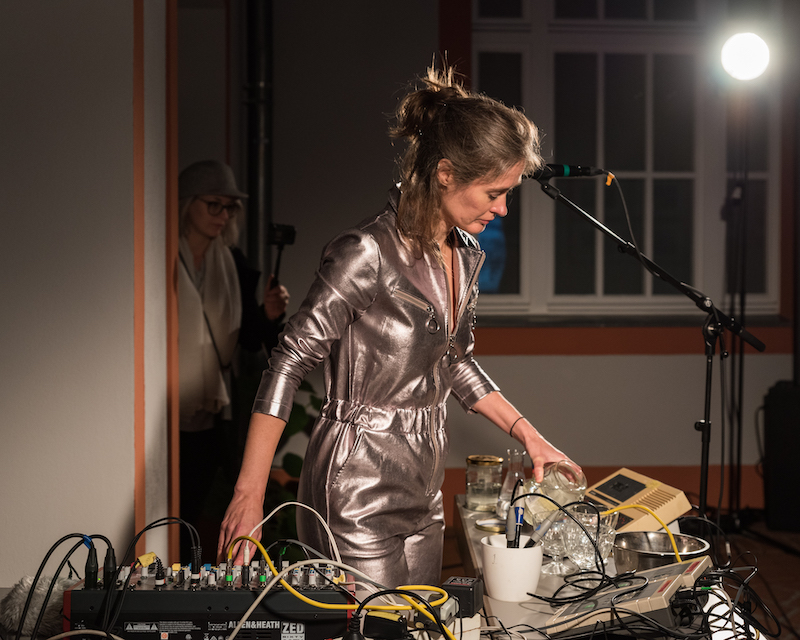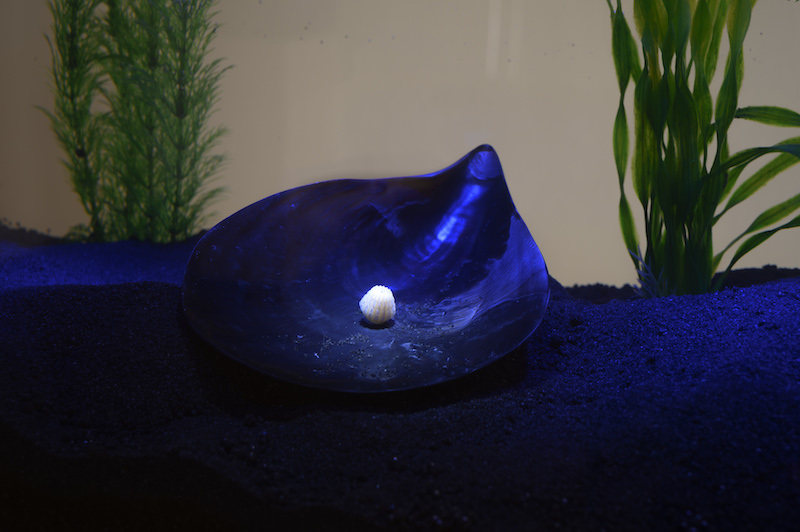by Nadia Egan // Apr. 14, 2022
As powerful institutions continue to downplay the detrimental repercussions arising from the use of fossil fuels, centering the demand on social and ecological justice is becoming more crucial than ever. In an exhibition that brings together artistic works and stories focusing on geographies increasingly affected by the energy production process, ‘Fossil Experience’ approaches the widely divergent—and in part violent—realities generated by the use of fossil fuels. Acknowledging that wealth is accrued by specific social groups, nation states and corporations through fossil fuels, the exhibition explores embodied vulnerabilities, cognitive dissonances and art-activist strategies in the representation of petromodernity.
We spoke with exhibition curator Lena Johanna Reisner and curatorial advisor Sonja Hornung about the inspiration and thinking behind their work, the participating artists in the show and the position of art in ongoing campaigns against the use of fossil fuels.

Ayọ̀ Akínwándé: ‘Ogani Cleanup,’ 2020 // Photo courtesy of the artist
Nadia Egan: How did you choose the topic and how has it inspired and driven your curatorial work?
Sonja Hornung / Lena Johanna Reisner: The notion of fossil experience points, on the one hand, to the acceleration made possible by the widespread availability of cheap energy, particularly in the second half of the 20th century. On the other hand, it refers to the traumas of extraction, exposure and displacement that threaten to further escalate as climate change progresses. By emphasising the notion of experience, we acknowledge that these dynamics are not “outside” of us, or “elsewhere”: one way or another, everybody has a fossil experience.
In ‘Fossil Experience,’ we wish to slow down narratives around the transition to renewables, which are currently easily manipulable by the interests of both nation-states and corporate players. Instead, we critically examine the extent of human reliance on fossil fuel industries, including far-reaching consequences for interwoven human and non-human ecologies. Artworks with points of contact to energy production have much to tell of the tight relationship between the capitalist growth imperative, ongoing colonial logics and energy production.

Kat Austen: ‘This Land is Not Mine,’ 2021, performance at Wendisches Museum // Photo by Studio Kat Austen, Andreas Baudisch, Wendisches Museum
NE: The exhibition and parts of the public program will take place in the Großer and Kleiner Wasserspeicher, two former underground water reservoirs. What was the reasoning behind this venue choice and how does it link to the works being shown?
SH / LJR: The exhibition is part of the re-opening year of Prater Galerie, a publicly-funded art space in the municipality of Pankow. When it became clear that renovations of the exhibition space at Prater would not be finished this year, we began looking for alternative sites.
The two Wasserspeicher are publicly owned remnants of Berlin’s water infrastructure. Almost all exhibited works raise the question of water—which is fundamental to all forms of life—as its quality and availability is compromised by large-scale industrial projects. So the exhibition resonates with the former function of the site. As underground spaces, the reservoirs are very immersive, creating space, we hope, for an embodied, focused exhibition.
NE: Which geographies does the exhibition focus on and how did you come to choose these? Can you tell us about some of the artists participating in the exhibition?
SH / LJR: Metropolitan life is irrevocably dependent on electricity and on petrochemical products, both of which are associated with the emission of greenhouse gases. For urban dwellers in Western Europe, this correlation can sometimes feel abstract. So we decided to focus on places of resource extraction, while questioning the politics of images of “faraway” environmental destruction displayed in comfort for a privileged viewer.
In Ayọ Akínwándé’s video performance ‘Ogoni Cleanup,’ the artist attempts to clean up a contaminated site in Ogoniland in the Niger Delta, using his bare hands and water canisters. Since oil was discovered in 1956 by Shell, the Delta region has experienced over 60 years of environmental pollution and human rights violations. ‘Ogoni Cleanup’ bears witness to the ongoing and urgent need for reparations in the wake of eco- and genocidal environmental racism, from which the Global North profits. These questions will be addressed by the exhibition’s fourth and final panel discussion, ‘Entanglements of Social, Environmental and Climate Justice.’
Of course, extractivism also affects places in the Global North and, as Kat Austen’s ‘This Land is Not Mine’ shows, it is brought to bear in specific ways in post-socialist regions. Austen’s new media project focuses on nearby Lusatia, where Germany, Poland and the Czech Republic meet, and where brown coal mining is currently being phased out. ‘This Land is Not Mine’ is a series of landscapes, waterscapes and soundscapes that trace the scars of—and incremental signs of regeneration from—brown coal extraction in naturecultures across the region. Monira Al Qadiri’s ‘Wonder’ thematises economies in the Arabian Gulf and Marjolijn Dijkman’s ‘Cloud to Ground’ speaks to questions of electrification and energy storage.

Monira Al Qadiri: ‘Wonder,’ 2016-2017 // Photo by Marius Land
NE: You mention how art can support ongoing campaigns against fossil fuel expansion projects. How do you see this exhibition and its related public program as contributing to that?
SH / LJR: On February 2nd, 2022, the European Commission declared nuclear power and “natural” gas to be “sustainable” energy sources. This was three weeks before Russia invaded Ukraine, with far-reaching effects on energy policy worldwide still unfolding. The roll-out of battery plants across the EU and Scandinavia, however, appear set to prioritise the resource-heavy production of private vehicles. The exhibition’s second discussion round, ‘Does this seem like a desert to you?,’ focuses on the threat to groundwater levels posed by Tesla’s recently opened Gigafactory in East Brandenburg, which supplies Berlin’s drinking water and which is already affected by drought.
Meanwhile, Germany is pushing ahead with the completion of three LNG import terminals to diversify its gas supply. Above all, US-American and Australian companies seek to cash in on speculative investments in fracking. Rachel O’Reilly’s feature-length experimental documentary ‘Infractions,’ which can be viewed in the exhibition, platforms frontline Indigenous artists and cultural workers—including Dimakarri ‘Ray’ Dixon (Mudburra); Jack Green (Garawa, Gudanji); Gadrian Hoosan (Garrwa, Yanyuwa) and Que Kenny (Western Arrarnta)—as they work against threats to more than 50% of the Northern Territory from shale gas fracking. As Australia upscales fossil fuels exports, pressure on this region has intensified, threatening hard-won Aboriginal land rights and homelands.
‘Fossil Gas is Not Clean’ is the title of the exhibition’s third discussion round, with O’Reilly, Dr. Christopher Basaldú (Carrizo Comecrudo, Texas) and Esteban Servat, an Argentinian scientist and exiled environmental activist. We hope that if art institutions and public programming are to make a small contribution to the work of challenging extinction-driven narratives, they might begin by acknowledging those who have already long been doing this work.
Exhibition Info
Prater Galerie
Group Show: ‘Fossil Experience’
Program: Apr. 7–May 19, 2022
Exhibition: Apr. 22–May 8, 2022
pratergalerie.de
Großer Wasserspeicher, Belforter Straße, 10405 Berlin, click here for map























